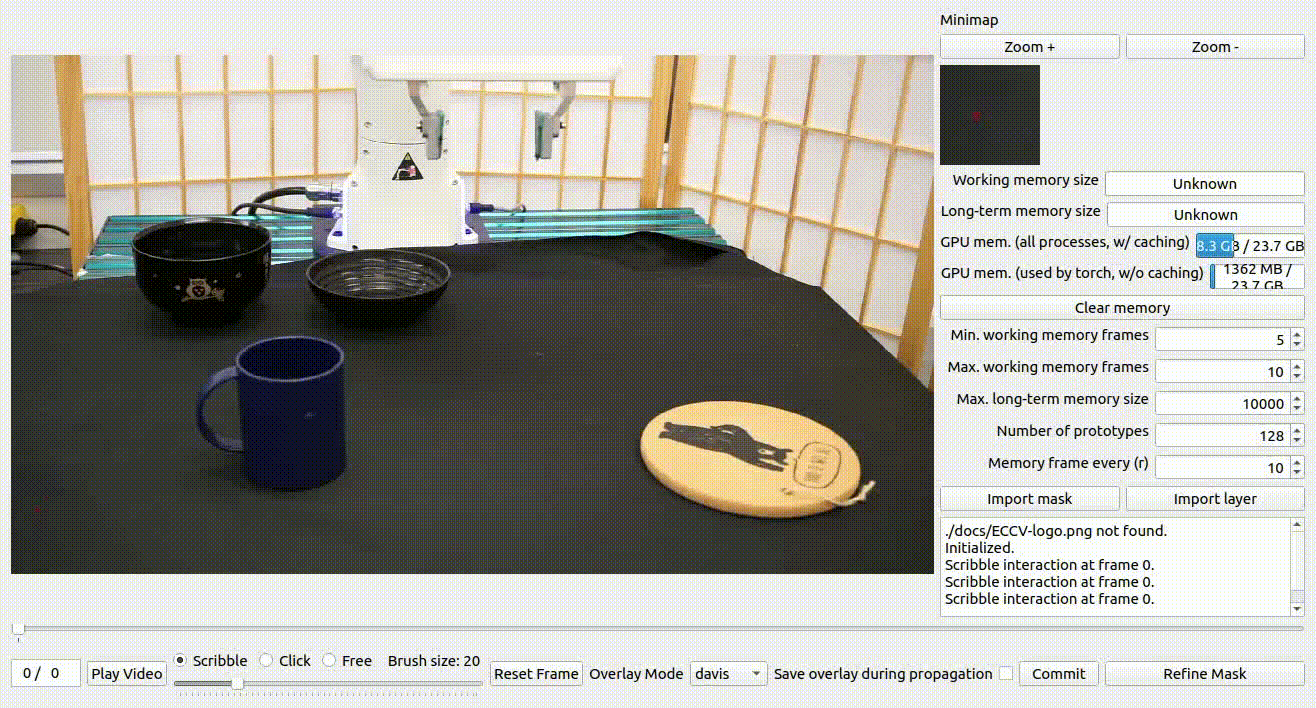Yifeng Zhu, Zhenyu Jiang, Peter Stone, Yuke Zhu
Our real robot experiments are based off of the control codebase Deoxys and its vision pipeline Deoxys-Vision (Coming soon!).
pip install -r requirements.txtIf you want to use this as a component, there is a easy way to allow you to access functions in groot. Simple do the following in your virtual environment:
pip install -e .We need to install the vision models and checkpoints in order to run GROOT codebase. Here is a simple bash script that takes care of everything and also make sure that you can download the same commits of the repos as I used for my experiments.
./setup_vision_models.sh
The resulting repo structure under third_party should be as follows:
third_party/
dinov2
segment-anything
XMem
sam_checkpoints
xmeme_checkpoints
This repo relies on deoxys_vision and deoxys_control to collect images and control the robot (Franka Emika Panda).
You will first need to reset the robot to an initial joint configuration. This is to allow you collect data from a fixed iniital state distribution.
python real_robot_scripts/deoxys_reset_joints.py
Collect demonstrations for a task. Specify the task name and consistently so that the code can successfully create the datasets later.
python real_robot_scripts/deoxys_data_collection.py --dataset-name DATASET_NAME
To curate the training datasets, there are three things to be done:
- create demonstrations
- annotate single-frame segmentation
- create point clouds to train policies fast
python real_robot_scripts/create_dataset.py --folder DEMONSTRATION_FOLDER
python scripts/interactive_demo_from_datasets.py --dataset_path DATASET_PATH --num_objects NUM_OBJECTS
By default, we assume you also annotate robotos during this process. This is for better performance of VOS without considering the robot as one of the objects, and also the GROOT policies assume that the input is including the robot point clouds, so the policy will exclude the robot's point clouds. Including this information is also beneficial for conducting ablation studies for your need. The process is adapted from the S2M GUI.
This component is made possible by S2M.
Simply run python prepare_training_set.py dataset_path=DATASET_PATH will do the work. The command is equivalent to the following one:
python prepare_training_set.py dataset_path=DATASET_PATH vos_annotation=true object_pcd=true pcd_aug=true pcd_grouping=true delete_intermediate_files=true
If the the script is terminated in the middle and you do not want to create the whole set of intermediate files, you can specify one of the procedure from true to false and the script will skip the corresponding operation. After this process, you will get a masks.hdf5 that stores the result from segmentation propagation, and a *_training_set.hdf5 file that saves all the inputs that are used during training.
python verify_camera_observations.py
- Reset to initial positions
python real_robot_scripts/deoxys_reset_joints.py
- Run evaluation
python scripts/real_robot_eval_checkpoint.py \
--checkpoint-dir CHECKPOINT_FOLDER \
--checkpoint-idx 100 \
--experiment-config real_robot_scripts/eval_new_instances/eval_new_instance_3.yaml
Details:
In the new instance case, the following script will be triggered: real_robot_scripts/real_robot_sam_result.py and subsequently auto_annotation/sam_amg.py.
And there will be multiple files stored for the case of new instances:
- The first frame captured by the camera:
evaluation_results/DATASET_NAME/first_frame - The outputs of SAM:
evaluation_reulsts/DATASET_NAME/masks - The output from cosine similarity:
annotations/DATASET_NAME/evaluation_{ID}
And the evaluation script will retrieve the image and annoation from annotations/DATASET_NAME/evaluation_{ID}.
- Run checkpoints:
python scripts/real_robot_eval_checkpoint.py --checkpoint-dir experiments_real/VOS_3D_Real_Robot_Benchmark_pogba/stamp_paper_aug/VOS3DSingleTask/VOS3DRealRobotMaskedNoWristTransformerPolicy_seed10000/run_002 --checkpoint-idx 100 --experiment-config real_robot_scripts/eval_new_instances/eval_new_instance_3.yamlSome common configs are pre-defined in a yaml file, and you only need
to specify the yaml file in the argument --experiment-config.
If it's for testing new instances, you need to make sure that you specify the same experiment config for a single object. Otherwise the annotation used for propagating the VOS model will not match.
For details, please refer to code_structure.md
groot/
# Detailed jupyter notebook to go through important components of the repo, including:
# - XMem tracking for robot data
# - Backprojection to point clouds
# - SAM result on robot data
# - DINOv2 result on robot data
walkthrough_example.ipynb
# Scripts that include:
# - Scribble to mask annotation
# - process dataset for faster training
# - Train robot policies
# - Evaluate robot policies
scripts/
groot_imitation/
# Groot algo repo that stores most of the policy components
groot_algo/
# separate model for Segmentation Corresponde Model (Paper Section 3.4)
segmentation_correspondence_model/ # segmentation correspondence model
## Configuration for third party models
vision_model_configs/
# Necessary scripts for real robot control
real_robot_scripts/
# third party models (Large vision models)
## Third party code repo
third_party/
